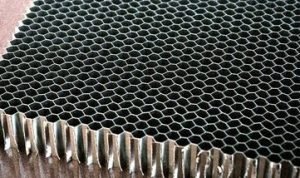Honeycomb Structure: its 4 Types, Manufacturing, & Applications
The honeycomb structure has the geometry of a honeycomb to allow the minimization of the amount of used material to reach minimal material cost and minimal weight and is a natural or man-made structure.
The common feature of the honeycomb structure is an array of hollow cells formed between thin vertical walls and in shape, the cells are often columnar and hexagonal. These structures provide a material with minimal density and relatively high out-of-plane compression properties.

By layering a honeycomb material between two thin layers that provide strength in tension, man-made honeycomb structural materials are commonly made and places where flat or slightly curved surfaces are needed, honeycomb materials are widely used.
Honeycomb Composites:
In many different environments, natural honeycomb structures occur and man-made honeycomb structures have been built with similar geometry which allows the reduction of the quantity of material used and results in minimal material cost.
Honeycomb structure with panels is shown in fig below;

The material has minimal density, strength in tension, and high out of plane compression properties in Man-made honeycomb structure because they have an array of hollow cells formed between thin vertical walls.
Manufacturing of Honeycomb Composites:
By using three conventional methods namely expansion, corrugation, and molding honeycomb structures are manufactured.
These days, honeycomb cores manufacturing involves the use of the corrugation and expansion processes where composite materials are used such as aluminum, fiberglass, and carbon fiber reinforced plastic. The raw material polypropylene is used to manufacture thermoplastic honeycomb cores by the extrusion method.
A more cost-efficient method for the manufacture of thermoplastic honeycomb structures enables the direct lamination of skin and continuous in-line production. From metal rolls by cutting and bending, continuous in-line production of metal honeycomb can also be performed.
There are also paperboard honeycomb materials that are being manufactured for use in package blocking and paper pallets, bracing, and cushioning apart from metal honeycomb composite structures.
Types of Honeycombs Composites:
There are four main types of honeycombs as given below;
- Aluminum Honeycombs
- Nomex Honeycombs
- Thermoplastic Honeycombs
- Stainless Steel Honeycombs
Aluminum Honeycombs:
Aluminum honeycombs possess the highest strength and weight ratio and have a mixture of geometric cell shapes and by foil thickness and cell size, the properties are controlled.

If applied in some applications such as marine structures, aluminum honeycombs are at risk of corroding, and upon impact, with a cored laminate this type of honeycomb deforms irreversibly.
Nomex Honeycombs:
Nomex honeycombs are manufactured by a type of paper-based on Kevlar fibers which is known as Nomex paper and with fire-resistant properties, these honeycomb cores combine high strength.

In aircraft interior panels as well as in other high-performance components these are used and due to their low density, solid stability, and mechanical strength, they are preferred. As compared to other materials they are more expensive.
Thermoplastic Honeycombs:
These honeycombs cores are easily recyclable and are lightweight and there are several types of these honeycombs such as;
- ABS offers surface hardness, toughness, rigid structure, dimensional stability, and impact resistance.
- Polycarbonate offers good light transmission, UV stability, self-extinguishing properties, and robust heat resistance.
- Polypropylene provides exceptional chemical resistance &
- Polyethylene is an inexpensive general-purpose core material.

Stainless Steel Honeycombs:
For hostile environments, stainless steel honeycombs cores are ideal and in train doors and floors, bulkheads, and other areas these are used.

Geometric Types of Honeycomb Structures:
A honeycomb is a space-filling or close packing of polyhedral or higher-dimensional cell in geometry and there are no gaps, and in any number of dimensions, it is an example of the more general mathematical tiling or tessellation.
In ordinary flat space honeycombs are usually constructed and also be constructed in non-Euclidean spaces like hyperbolic honeycombs and to form a uniform honeycomb in spherical space any finite uniform polytope can be projected to its circumspect.
Applications of Honeycombs:
There are many applications of the honeycombs such as;
- Jet aircraft and rocket substructure.
- In light, water, fluid, and air fictionalization.
- In electric shielding enclosures and wind turbine blades.
- In exterior architectural curtain wall panels and clean room panels.
- These are energy absorption protective structures and also used for forming doors, floors, energy absorbers/bumpers, and furniture in the rail industry.
We Love Cricket
